ACT II: ADDENDUM 3
Among 9-11 skeptics, there has been considerable debate over the size of the alleged entry hole that was created by whatever it was that hit the Pentagon on September 11, 2001 (assuming that something did, in fact, hit the Pentagon). More than a few researchers have claimed that the supposed entry hole was large enough to accommodate the fuselage of a Boeing 757-200 aircraft. I find it hard to discern such a hole in any of the available pre-collapse photographs (to clarify here, I define the word “hole” to mean a clean penetration into the building, unobstructed by partially intact columns and the like), but let’s assume, for the sake of argument, that such an opening did exist.
The size of the opening that has been claimed – generally around 16 to 18 feet wide – leaves little margin for error in accounting for an angled entry by an object measuring roughly 12½ feet across (http://www.boeing.com/commercial/757family/pf/pf_200tech.html). Accepting the claim that a Boeing 757 entered the Pentagon in such a manner requires accepting that there was no deformation of the fuselage due to compacting, and, more importantly, that the wings and tail sections of the plane were sheared cleanly and completely off, leaving only a decidedly phallic object that then slid cleanly into the building like … well, use your imagination on that one. This is a family newsletter. Sort of.
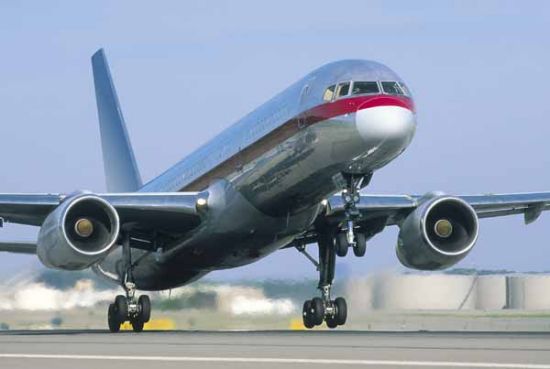
When reading through Pentagon crash theories, it is nearly impossible to avoid frequent encounters with the word “confetti,” as in statements such as: “the plane’s wings were reduced to confetti.” On many websites, it seems to be generally accepted as a truism that passenger airplane wings will not only snap off as easily as the wings on a child’s balsawood glider, but will thereafter disintegrate into such fine particles that they all but disappear.
Now, I will freely admit that I am not an aircraft engineer and I have never worked on the design or manufacture of commercial aircraft. But that’s okay, because neither have any of the people who talk incessantly about airplane wings being reduced to confetti. And as is so often the case, all we really need do here is apply a little logic and common sense and we should be able to determine, with a reasonable degree of certainty, how likely it is that the wings of a Boeing 757-200 aircraft could be sheared off and/or reduced to confetti.
As can be clearly seen in the accompanying photos of just such an aircraft, the most prominent feature of the wings are the enormous engines hanging from each of them. Those engines weigh in at roughly 9,000 pounds each – nearly 12,000 pounds each if we factor in the steel struts that support them (according to pentagonresearch.comand the ASCE). Some researchers have already pointed out that the aircraft’s wings have to be quite strong to support those massive engines. That much seems rather obvious. Of far more significance, I would think, is that those engines are what propels the plane. In other words, in order for the plane to actually lift off the ground and fly, the engines, and hence the wings, have to literally drag that fully-loaded, 127-ton aircraft into the air and then pull it along to its destination.
It seems to me then that if a 757’s wings were as flimsily attached to the fuselage as many researchers claim, we would regularly be treated to rather comical scenes of wingless jets sitting on runways while the wings themselves took flight in wild, unpredictable ways. And that’s not the kind of thing you see on the evening news that often.
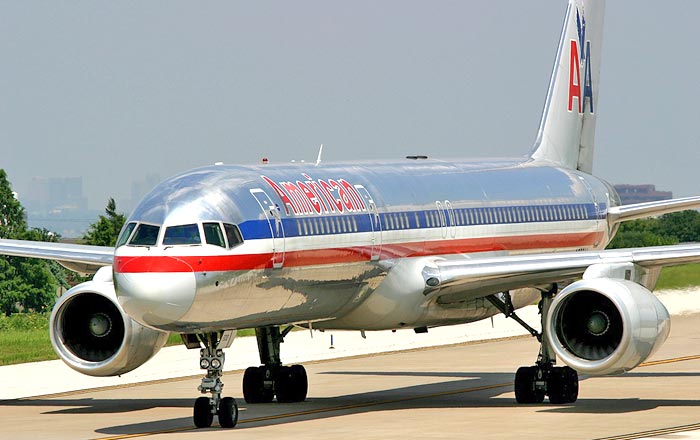
Also clearly visible in these photos is the aircraft’s main landing gear, which also happens to be attached not to the fuselage, but to the wings. That landing gear adds nearly two tons of weight to each wing. More importantly, the fact that the gear is attached to the wings means that when the plane is on the ground, it is the wings – described by more than a few 9-11 skeptics as consisting of little more than a thin aluminum skin – that have to support almost the entire weight of the aircraft (up to 255,000 pounds at take-off). And when the plane lands, needless to say, that landing gear provides the first point of contact with the ground. It also provides the primary means of braking the aircraft to a stop. It seems safe then to conclude that the wings can not only support the entire weight of the plane but can also simultaneously arrest its considerable forward momentum. Imagine the stress that is placed on that landing gear as a 200,000+ pound airplane skips down the runway at a relatively high rate of speed and it becomes quite clear that the landing gear, and the wings themselves, have to be very securely attached to the fuselage.
Indeed, the area of the plane with the greatest structural strength, by any logical analysis, would have to be the span between those two enormously heavy, and enormously powerful, engines. In other words, the wings are not some insignificant appendages that are tacked on with a few aviation rivets and a wad of bubblegum; they are an integral part of the aircraft.
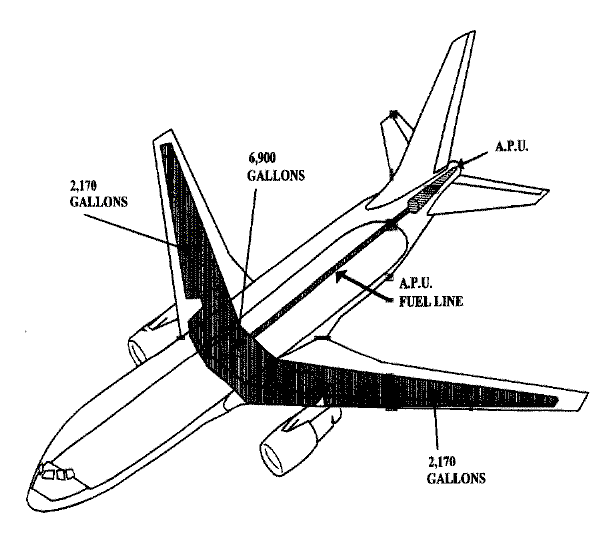
In addition to the engines and the main landing gear, the wings are also home to the aircraft’s fuel tanks, which carry a combined 11,240 gallons of fuel (at least according to the graphic reproduced here; fuel capacity is listed elsewhere as 11,489 gallons or 11,275 gallons), weighing some 75,000 pounds. Each wing holds nearly 15,000 pounds of fuel and another 45,000 pounds, more or less, is stored in tanks between the wings.
According to the American Society of Civil Engineers, each wing of a Boeing 757-200 weighs in at a whopping 44,000 pounds, including the engine and struts, the landing gear, a full load of fuel, and the weight of the wing structure itself (steel and other metals account for about 2/3 of that weight, or roughly fifteen tons, with the fuel accounting for the other seven tons). If we add together the weight of the two wings (88,000 pounds), the weight of the fuel stored between the wings (45,000 pounds), and the weight of the heavily reinforced cross-section of the fuselage between the two wings, we come up with a figure, I would guess, somewhere in the neighborhood of 150,000 pounds. Since a fully fueled Boeing 757-200 weighs in at roughly 200,000 pounds (127,000 pounds for the aircraft and 75,000 pounds for the fuel), a little rudimentary arithmetic reveals that fully 3/4 of the aircraft’s weight is distributed in the cross-section between the wing tips. The bulk of the fuselage, which appears to be the most massive portion of the plane, in reality accounts for only about 25% of the aircraft’s total weight.
What the “plane-bomb”/”confetti” theorists would have us believe then is that the area of the plane with by far the greatest structural strength, greatest mass, and greatest density, is the section that was magically reduced to confetti, while the relatively lightweight, low-density and low-strength fuselage punched cleanly through the reinforced masonry walls of the Pentagon.
Jean-Pierre Desmoulins, for example, has created a series of images, including the one below, to illustrate how the wings of a 757 will allegedly snap cleanly off on impact, while the turgid fuselage will, of course, plow cleanly through pretty much any obstruction — even though the fuselage is, in reality, little more than a reinforced aluminum tube filled, in large part, with a mixture of air and relatively soft materials like luggage and human bodies. (And yes, by the way, I do realize that that sounds very similar to the claim made by Michael Rivero that I earlier ridiculed. What’s your point?)
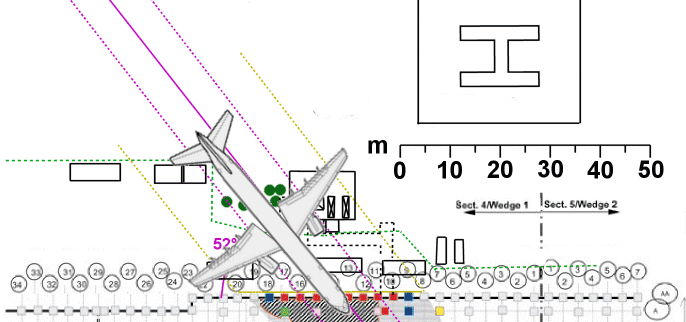
I can’t imagine that an actual 757 aircraft would ever perform in the real world as this one does in Desmoulins’ world. To the contrary, what would most likely happen is that the nose of the plane, from the very moment of initial impact, would begin to compact. The effect would be very similar to the workings of a vice, with the two-foot-thick Pentagon wall serving as the stationary jaw of the vice and the extreme forward momentum of the 150,000 pound wing section serving as the other. In other words, the effect would be akin to stomping on an upright aluminum can, with the ground representing the Pentagon, the empty can serving as the forward section of the fuselage, and your foot filling in for the wings of the plane.
The initial compacting, needless to say, would occur nearly instantaneously and would be quickly followed by the impact of the plane’s wings and engines, bringing the full weight of the aircraft to bear on the front wall of the Pentagon. It is certainly possible that, at that time, the tips of the wings – which is to say, the area beyond the engines – could be sheared off or bent back. But it is extremely unlikely that the wings would be sheared off completely, and it is inconceivable that they would break off before even impacting the building.
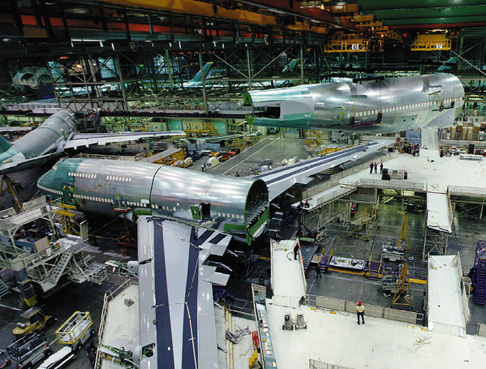
It should be noted here, before moving on, that Desmoulins did get one thing right with his series of fanciful impact images: the deflection of the plane upon impact with an angled surface is clearly illustrated. In the image above, the aircraft has already begun to veer from its initial course. In subsequent images, Desmoulins depicts the plane deflecting further still from its trajectory. Curiously though, Jean-Pierre forgets to mention that this deflection completely invalidates the claim that the aircraft somehow managed to punch out an exit hole that was directly in line with the initial trajectory of the plane rather than with the deflected trajectory. But here, I suppose, I have digressed.
As can be clearly seen in the photograph to the right, taken at a Boeing assembly plant, an aircraft of the Boeing 7X7 family is not assembled by slapping a couple of flimsy wings onto the fuselage. To the contrary, the wing section is quite obviously manufactured as a single unit — and necessarily so, for there are undoubtedly continuous steel structural elements that run through the wings from engine to engine. The tail sections appear to be separate pieces, to be sure, but the wings are clearly an integral component of the main body of the aircraft. They are not separate structures that can snap off at the seams because, as it turns out, there are no seams. The only seams, as is clearly evident, are in the fuselage.
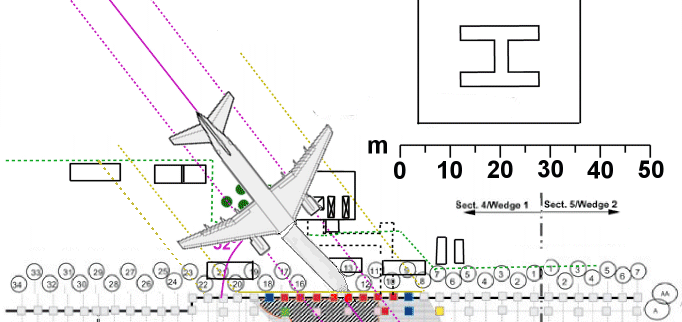
Given that any seams are inherently the points of greatest structural weakness, and given also the angle of impact, it seems reasonable to conclude that if the aircraft was going to begin to break apart upon initial impact with the exterior wall of the Pentagon, it would do so as depicted in the graphic to the left (which I, utilizing my obviously formidable skills at computer animation, have taken the liberty of adapting from one of Desmoulin’s impact images). Such a crash scenario, needless to say, would not have resulted in a ridiculously small entry hole coupled with a complete lack of aircraft debris deposited outside the building, but it would be consistent with the actual design characteristics of the aircraft that purportedly created that entry hole.
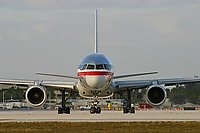

The bottom line here, it seems to me, is that the existence of a 16-18 foot wide hole in the face of the Pentagon does not even begin to explain the complete disappearance of a Boeing 757-200 aircraft. Such an airplane, viewed head-on, looks much like the photo to the left. The “confetti” theorists would have us believe that that entire aircraft can disappear, without a trace, into an entry hole not much larger than the diameter of the fuselage, as is crudely depicted in the image to the right. In reality, the design and weight distribution of a 757 strongly suggest that the smallest possible entry hole would actually look like the equally crude image to the lower left.

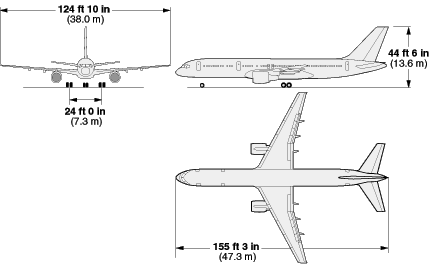
The difference is certainly not an insignificant one. An entry hole such as the one to the left would have to be about 50 feet wide. And as even the “plane bomb”/”confetti” theorists acknowledge, there was no such hole in the Pentagon’s façade. What that means, needless to say, is that no Boeing 757 or similar aircraft crashed into the Pentagon on September 11, 2001, regardless of whether or not there was an identifiable entry hole measuring some 16-18 feet across. Such an entry hole might be consistent with a missile strike, but it certainly is not consistent with the crash of a Boeing aircraft with wing-mounted engines.
Speaking of missiles, our old friend Donald Rumsfeld, last seen providing the very first identification of the aircraft that supposedly hit the Pentagon, apparently decided later that it was actually a missile that had done the damage. In an interview with Parade magazine dated October 12, 2001, Rumsfeld had this to say:
Here we’re talking about plastic knives and using an American Airlines flight filed [sic] with our citizens, and the missile to damage this building and similar (inaudible) that damaged the World Trade Center. The only way to deal with this problem is by taking the battle to the terrorists, wherever they are, and dealing with them. (http://www.defenselink.mil/transcripts/2001/t11182001_t1012pm.html)
Rumsfeld’s interviewer, Lyric Wallwork Winik, did not bother to ask for clarification of the missile reference. Some researchers have claimed that Rumsfeld’s choice of words was deliberate – that his goal was to plant a ‘meme’ that would misdirect the efforts of 9-11 researchers. Many of the researchers making that claim, however, are the same people who have spent the last several years muddying the waters, planting red herrings, and working diligently in various other ways to sabotage the efforts of other theorists.
This was not, by the way, the only ‘meme’ that has been planted by Herr Rumsfeld. In an address to U.S. troops in Baghdad, the Secretary of Preemptive War let slip a curious remark about United Airlines Flight 93: “the people who attacked the United States in New York, shot down the plane over Pennsylvania …”
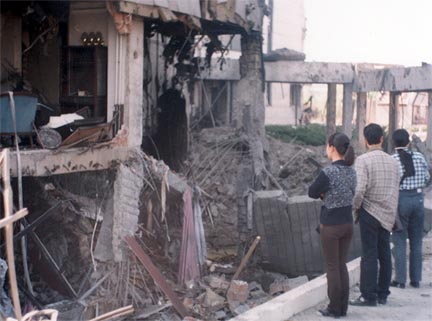
So I guess Rumsfeld is either very skilled at planting ‘memes,’ or he is not very good at keeping secrets. Let’s assume, since we know that Flight 93 was indeed almost certainly shot down, that Rumsfeld has a bad case of Freudian diarrhea-of-the-mouth and was actually telling the truth about a missile strike at the Pentagon. Such a scenario, of course, would not offer a complete explanation for what happened at the Pentagon on September 11, 2001. It would not explain, for example, the alleged ‘exit hole,’ nor the downed light poles (which, unfortunately, I must return to in the next outing; who knew that breakaway poles really do exist?). But it would explain the pre-collapse damage to the exterior of the Pentagon and the alleged flight characteristics of whatever it was that may or may not have hit the building.
If it had been a late model, American-made cruise missile that slammed into the Pentagon on the morning of September 11, it likely would have left impact damage very similar to the damage done by the American-made cruise missiles that slammed into the Chinese embassy in Belgrade during the ‘liberation’ of Kosovo. And curiously enough, the low-altitude impact of those missiles created entry wounds that should look at least vaguely familiar to anyone who has taken a serious look at what really happened at the Pentagon that fateful morning.
* * * * * * * * *
Some researchers have applied the same faulty “flimsy wings” arguments to analyses of the crashes at the Twin Towers. Consider, for example, the following excerpt from a piece penned by Australian researcher Gerard Holmgren:
When you sit in a passenger jet and look out the window to the wings, what do you see? A light aluminum structure which is segmented into panels and movable flaps. Hardly a cutting blade or battering ram, except against light materials. The WTC was constructed of heavy construction steel, built to withstand hurricanes. We are asked to believe that such flimsy aluminum wings sliced through this structure decisively enough to make a cartoon type shape of themselves.
Holmgren might just as easily have made another argument that would have been equally as valid:
When you look up at the World Trade Center Towers (prior to September 11, of course), what do you see? A lightweight structure composed of individual glass panels separated by light gauge aluminum mullions. Hardly an effective barrier, except against very lightweight and slow-moving projectiles. The attacking aircraft weighed 100+ tons and was traveling hundreds of miles per hour. We are asked to believe that such a projectile would not have passed cleanly through the building.
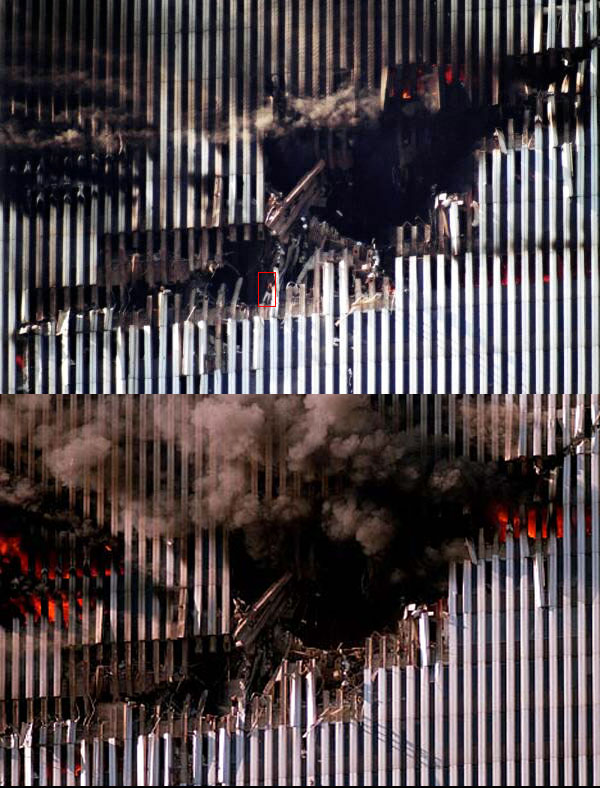
The fatal flaw in both these arguments, of course, is that they ignore an adage that any school kid is familiar with: never judge a book by its cover. What you see when you look at the wings of a passenger aircraft has no relevance for determining the composition of those wings, just as what you would have seen when looking at the Twin Towers would have been of little help in determining the structural characteristics of those buildings. Holmgren seems to recognize that fact in regards to the towers, but certainly not in regards to the aircraft — an oversight that has lead him to amusingly characterize as “flimsy” two 22-ton, steel-and-aluminum structures that were capable of handling a dynamic load well in excess of 100 tons.
What Holmgren and some others in his clique have argued, essentially, is that the existence of a hole the size and shape of a 767 aircraft in the side of one of the Twin Towers is proof that a 767 aircraft did not create that hole. “This kind of thing,” says Holmgren, “might happen in cartoons,” but not in the real world.
This same group, it should be noted, has steadfastly maintained that there was no plane crash at the Pentagon on September 11, a conclusion based in part on the fact that there was no entry hole consistent with the crash of a passenger plane. Fair enough. But in the case of the WTC attacks, they have reached the same “no planes” conclusion, this time based in part on the fact that there was an entry hole conforming to the dimensions of a Boeing aircraft. It would seem that some researchers have chosen to set the bar rather high.
Other researchers, curiously enough, have concluded that the impact hole in the side of the World Trade Center did not conform closely enough to the outline of a Boeing 767. These theorists have noted that while there is a gaping hole at the center of the impact zone, there are no actual ‘holes’ where the outer portion of the wings would have impacted. There is obviously substantial damage to the exterior of the building in those areas, but there is not a clean penetration. Based on this observation, these researchers, like those in the other clique, have concluded that the impact hole was faked with either conventional explosives or some sort of ‘black’ technology.
Both subsets of researchers, it seems to me, are mistaken. The reality is that the weight distribution and design characteristics of a Boeing 7X7 aircraft would seem to indicate that an impact hole should look remarkably like the hole photographed in the side of the World Trade Center tower on the morning of September 11 – with a clean penetration at the center of mass and substantial damage, though not necessarily penetration, at the wing extremities.
There was no such penetration at the Pentagon. And no amount of delusional theorizing about flimsy, conveniently self-destructing airplane wings will ever change that fact.

Not related to the Pentagon but I want to post it while I remember it- the equally “cartoonish” Flight 93 “impact site” (which had almost none of the scattered debris since the plan was shot down in reality) had a central “crater” and two deep cuts resembling wings.
The problem for the official (fictional) lapdog media narrative is, historical photos clearly show that the wing-shaped gash was already there, and that a missile was then fired into the center of it to create the fake crash site.
Oops.
This happened 22 years ago from the space-time bubble that I now inhabit. I have time to think about it now. This story gives me goosebumps. I remember watching the demolition of the WTC buildings, and seeing the tiny hole in the side of the Pentagon. I thought, and when I opened my mouth there was always somebody to present a theory or ridicule mine. So I shut up. I needed to make a living and not live in a state of cognitive dissonance. There are no answers. Just a feeling that maybe the four horsemen started riding on that day. And they still are. And that is what gives me the feeling of goosebumps, as I was an atheist who gave up religion many years ago.